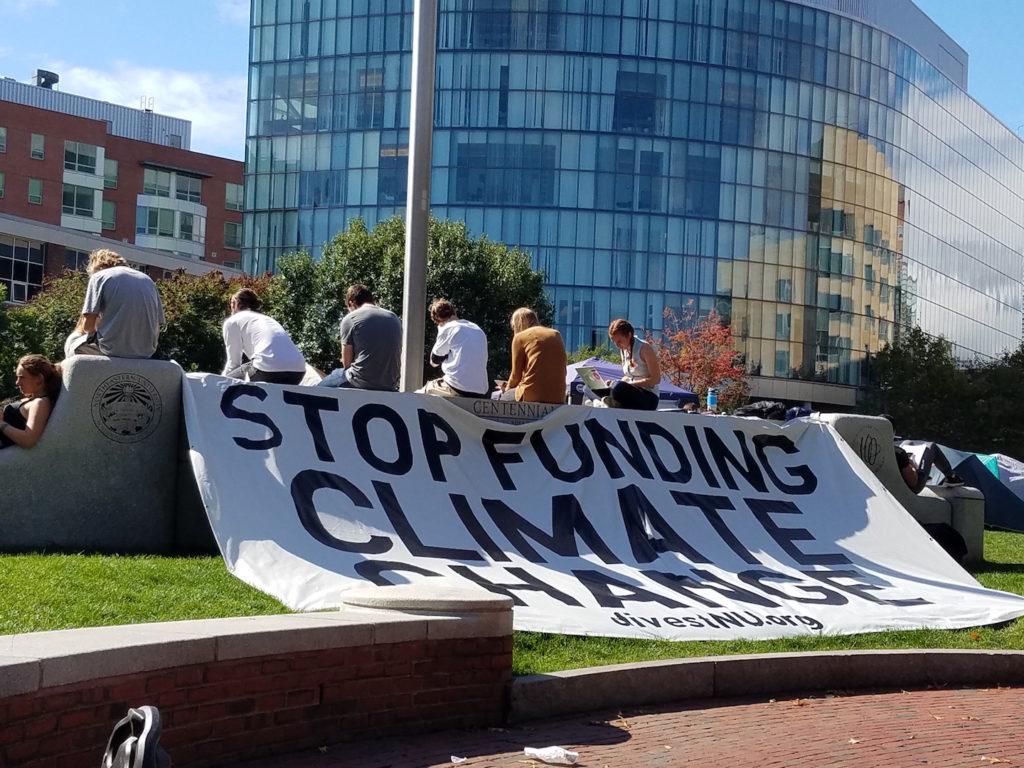By Rowena Lindsay, news staff
The protesters started setting up camp on Centennial Common at 7:45 a.m. on Monday, Oct. 3. First came the tents, about a dozen of them scattered across the lawn, although the number soon grew.
Then signs and banners: “Stop funding climate change,” one reads. “Oil money is blood money,” shouts another.
And finally the chorus of chants: “Hey Northeastern, practice what you preach. Climate justice and free speech!”
Members of the DivestNU student movement have vowed not to leave Centennial Common until Northeastern University (NU) administration agrees to move forward on divesting its endowment money from fossil fuel companies—even if that means possibly getting arrested.
“The reason we are here is to push our university to reconcile its relationship to the fossil fuel industry and answer the calls of its student body to end its legitimization of what is a rogue industry,” said Austin Williams, a senior environmental studies and political science major and co-founder of DivestNU. “That being said, we have put our members through nonviolent civil disobedience trainings, they’re prepared for the possibility of arrest and they are prepared to do what it takes to make sure that the university hears the student voice.”
So far, it has not come to that.
Five days into its occupation of Centennial Common, DivestNU is going strong. Over 100 student supporters have shown up for their rallies each evening, including some from other Boston schools fighting their own divestment battles.
While the administration hasn’t forced the group to leave, it hasn’t engaged with the issue of divestment since the protest began, either, beyond issuing a statement acknowledging the protestors.
“A passionate and engaged student body is one of the hallmarks of a great university,” Matthew McDonald, director of communications at Northeastern, said in an email to The News on Oct. 6. “We encourage a spirited exchange of ideas on our campus, and we commend these students for their continued passion to address the challenge of global climate change.”
The occupation of Centennial Common is just one step in a four-year campaign by DivestNU, a student group that formed in spring 2013 with the goal of convincing Northeastern’s Senior Leadership Team (SLT) and Board of Trustees to pull all of the university’s current and future endowments out of the fossil fuel industry. The coalition believes that divestment would align with the school’s interests and benefit the university in the long run. The group has 30 core members and is part of a global divestment effort that aims not to financially harm the companies that contribute to climate change, but to socially stigmatize them.
The movement touts itself as a social justice issue rather than an environmental one, focusing on the disproportionate effects climate change has on disadvantaged people and countries. But divestment can be a tough sell for large institutions, even when they are committed to being environmentally conscious and globally minded.
In a meeting with Thomas Nedell, the treasurer and senior vice president of finance at Northeastern, DivestNU determined that between $30 and $60 million – approximately nine percent of Northeastern’s $729 million endowment – is invested in the “energy” sector, which includes fossil fuels, utilities, pipeline distributors and renewable energy.
“The university does not hold any direct investments in energy companies, due in part to the fact that endowments of this size rely primarily on commingled investment funds that include investments from a broad range of economic sectors,” McDonald said in the Oct. 6 statement.
Northeastern has not invested directly in fossil fuel companies, which puts it ahead of many universities that do. Instead, its investments are primarily in commingled funds – predetermined portfolios that expose endowment money to many different sectors, including fossil fuels. This can make the technicalities of divestment difficult, but Northeastern’s endowment manager, Cambridge Associates, offers fossil fuel divestment services.
“It isn’t so much about how difficult the process of divestment will be, but what sort of policy the university is going to set,” Williams said in November 2015.
Since then, the university has set a policy. In July, Northeastern announced that it would invest $25 million of its endowment in sustainability over the next five years. The press release said it was a purposeful choice to invest, as opposed to divest, to ensure that the school keeps a strong endowment while investing in the planet’s future.
DivestNU saw this as a betrayal of the negotiation process it had spent years engaging the administration in.
“We have given them all the information they could possibly want: The financial information on divestment, the risks they run by investing in fossil fuels, the ethical arguments, statistics on climate change,” Alissa Zimmer, junior environmental studies major and DivestNU member, said. “It is not about ignorance; it is about having all the facts and choosing to ignore this crisis that is putting people’s lives at risk.”
Divest movement in context
Fossil fuel divestment is not exclusively a student movement. Many religious groups, foundations, government organizations, nongovernmental organizations and pension funds have divested fully or partially from fossil fuels.
Massachusetts has long been a hub of divestment activity. The John Merck Fund, the Chorus Foundation and the Solidago Foundation—all Massachusetts-based foundations—divested in 2014, and in the state legislature, Sen. Ben Downing, a Democrat from Pittsfield, wrote a bill requesting that the $56 billion state pension fund divest from fossil fuels.
However, some of the most significant progress has been at the university level. According to data from GoFossilFree.org, 32 colleges and universities in the U.S. and 72 worldwide have committed to divesting, including the University of Massachusetts, which became the first major public university to divest from all direct fossil fuel holdings in May 2016.
Recently, Boston University stated that it will avoid investments in companies that extract coal and tar sands. Divest BU released a statement on its Facebook page saying it was not satisfied with the university’s decision. Harvard University’s divestment movement has had an even more difficult time getting school official to take action. In November 2014, some members of the group filed a lawsuit against the university to compel it to divest its $37.6 billion endowment—only to have the case dismissed five months later.
“Divestment at the university level is important because [universities] actually hold a lot of money and there are thousands of them in the U.S.,” Becca Rast, U.S. campus divestment organizer at grassroots climate movement 350.org, said. “Historically, universities have been an important weathervane of politics in this country. The media looks to what is happening at universities, what young people are talking about.”
Throughout history, student movements have been an important catalyst for social justice movements.
In 1960, four black students from North Carolina Agricultural and Technical State University sat down in a “whites only” lunch counter. They not only refused to leave, but came back every day for six months, leading to the birth of the nationwide Civil Rights Movement.
Similarly, the sizable anti-Vietnam War movement was driven by student protesters at universities across the country who were simultaneously opposing President Richard Nixon’s support of the oppressive regime of South Vietnamese President Ngo Dinh Diem.
DivestNU’s cause is climate justice. The movement frames climate change as a political and ethical issue, where rich countries like the United States contribute the most to climate change and are most capable of dealing with the effects, while less-developed countries that contribute the least are affected first and are not equipped to deal with the consequences.
This can be seen in how different communities are capable of responding to the increasingly powerful storms driven by a changing climate.
“The storm arrives where it arrives, and there are wealthy people and there are poor people,” Astrid Caldas, a climate scientist at the Union of Concerned Scientists, said in an interview with the Christian Science Monitor. “The wealthy population has the resources and protections and information to ride the storm and to bounce back, but the poor and disadvantaged communities don’t have those resources, and so they are hit disproportionately hard.”
Climate justice is an intersectional issue as well, meaning the effects of climate change are compounded when combined with other marginalized identities, including race, gender and ethnicity.
“That is why the environmental justice movement is gaining so much strength: because climate change and these types of events that can be made worse by climate change are multipliers of issues that already exist,” Caldas said.
Students press on, the university stalls
DivestNU first ran afoul of the administration in April 2013, when a group of students delivered a first letter of intentions to Northeastern University President Joseph E. Aoun’s office, asking the university to freeze all new investments in fossil fuel companies and then to gradually divest all holdings over a period of five years.
According to the Student Organization Handbook, no person can organize or hold a demonstration on university property or in connection with a university event unless they reserve the space and obtain the necessary permits from the Center for Student Involvement. Despite having cleared the petition with Aoun’s office, DivestNU violated this code.
“Frankly, we think that the policy is specifically intended to crack down on student organizations that directly threaten the administration’s interests,” Williams said. “These regulations are rarely enforced when a student organization is not directly challenging the administration’s status quo. Those rules are on the book to make sure that there is a way for the university to respond.”
Nearly three years later, thanks to the strength of the divestment coalition—a group of over 30 student organizations that have expressed support for the divestment campaign—DivestNU has enough clout to have reached a point of near immunity in regards to this rule. At this point, shutting down DivestNU protests would run the risk of drawing unwanted attention to the issue.
DivestNU’s first big victory took place in March 2014, when the group put the issue of fossil fuel divestment to a vote in the Student Government Association (SGA) elections and the student body voted in favor of divestment.
Of the 3,625 students who voted, 75 percent voted in favor of divestment. For the first time in nine years, enough students voted that the election period did not need to be extended in order to achieve the required 20 percent of the student body to validate the election.
“The fact that they didn’t need to extend the voting was a big deal because those people were there to vote on divestment, not so much the president,” Mara Scallon, an environmental studies major who has since graduated, said. There was only one candidate for SGA president on the ballot that year.
The referendum added legitimacy to the DivestNU campaign and has kept the administration at the negotiation table.
In response to the referendum, the administration announced it would create a Social Impact Council (SIC) in December 2014. The council was headed by Madeleine Estabrook, vice president of student affairs, and designed to address Northeastern’s policy regarding social issues. DivestNU was given a representative on the council and told divestment would be one of the first topics of discussion, but it took over a year for the committee to select members, ratify a charter and get to work.
“Now here we are, one year later, and nothing has come out of SIC,” Scallon, who was the DivestNU representative on the council, said in November 2015, at which point SIC had met only a few times.
These kinds of institutional obstacles are not unique to Northeastern, as seen in the cases of BU and Harvard’s divestment campaigns.
“We have seen it in almost every school,” Rast said. “Serious roadblocks from the administrations ranging from five-month-long committees, not even meeting with the students, making them go through student government before coming to the administration. Every school has its own tactics, but there has been a serious trend of that happening.”
This is particularly frustrating for the DivestNU campaign, which has made a pointed effort to play by the administration’s rules.
“I do believe in student government, and I do think that working with the administration and with student leaders is the way to go,” Anne Marie Barrett, a junior mechanical engineering major and former DivestNU representative to SGA, said. “But I am very frustrated right now with the administration, because they are not playing by their own rules that they set up to work with students.”
SIC did eventually release a comprehensive report recommending divestment and outlining how the university could best implement the policy in March 2016, two years after the referendum passed. A month went by without any response from the SLT. DivestNU then proposed a one-year timeline for discussing divestment with the Board of Trustees. In April, when there was still no response from the administration, DivestNU tried to force a reaction.
Twenty students from the DivestNU coalition spent April 21 in the Visitors Center facing the threat of arrest as they attempted, unsuccessfully, to negotiate a timeline with Estabrook. Estabrook didn’t respond to multiple requests to comment for this story.
“We chose to sit in the Visitors Center because we know from experience that the administration doesn’t really care about what students have to say, but they care a lot about prospective students and the money you give back to the school after you graduate,” Zimmer said. “We wanted to make sure we were in a place where they would be forced to pay attention to us.”
Northeastern broke its silence over the summer, a strategy the DivestNU campaign expected, since the response would be softer with fewer students on campus, according to Zimmer.
In a move that both responded to and denied the group’s recommendation, Northeastern announced in July that it would invest $25 million of its endowment in sustainability, including clean energy, renewables, green building and sustainable agriculture.
“Northeastern is already a sustainability leader when it comes to how we operate our campuses, educate our students and focus our research,” Nedell said in a statement. “Today we are furthering this leadership by proactively setting aside a portion of our endowment for investments in sustainable ventures. We have deliberately chosen to invest, not divest. This approach is consistent with Northeastern’s character as an institution that actively engages with the world, not one that retreats from global challenges.”
Nedell and other members of the SLT declined to comment for this story.
Members of the DivestNU campaign feel that the university set up a false dichotomy by portraying investment in sustainability and divestment from fossil fuels as mutually exclusive.
“The administration fails to grasp the extent of the action that is required to mitigate the effects of climate change,” Williams said. “It demonstrated to us that what Northeastern is primarily concerned about was not the technical or feasibility concerns of moving money in the endowment, but rather whether they would be forced into a position where they would need to question or sever their relationship with the fossil fuel industry.”
Precedent and the power of the endowment
Northeastern and other large private universities can be reluctant to divest from fossil fuels for a number of reasons. For example, Northeastern may not want to set a precedent for other student divestment campaigns, such as Students for Justice in Palestine’s Israel Boycott, Divestment and Sanctions (BDS) movement. But profits are almost certainly a big concern as well.
“A lot of these schools are run like companies and not institutions of moral learning,” Rast said. “You see that when you get to the top. The same questions that companies ask are being asked by universities. Profit is the bottom line.”
Since Northeastern is a private university, there is no legal requirement for the school to divulge any information about the endowment. All the numbers acquired so far by DivestNU have come from Nedell and other administrators during meetings or were taken from the university’s consolidated financial statements.
Less than nine percent of the endowment could feasibly be invested in fossil fuels, which may make the process of divestment simpler.
“It is harder to make the case that the endowment is going to go under if it does not have investments in fossil fuels,” assistant professor of finance at Northeastern Nicole Boyson said.
However, she made it clear that pulling endowment money out of commingled funds could be a complicated and potentially expensive process, depending on the flexibility of the endowment manager to move the endowment to a separately-managed fund.
Northeastern’s endowment manager, Cambridge Associates, has compiled a detailed report to guide institutions through the divestment process. It urges caution and asks universities not to simply “adopt the requests of an advocacy campaign,” but rather to focus on the institution’s beliefs and generate risk-adjusted profits.
“Ideally, you want to stay true to your values and not invest in things you dislike, but the practical side is that you are also under a fiduciary obligation to make money for the university,” Boyson said. “If you can’t get performance without these stocks, it makes it more challenging to explain these things to a board of directors.”
Some students are concerned about those financial aspects. They worry the school will lose money if its endowment is not exposed to the fossil fuel industry as Northeastern’s financial managers have seen fit, which may affect tuition, financial aid or the opportunities available to students at the school.
“With divest, as far as actually getting the money out of all those accounts, it is very hard, and with that, there aren’t too many hedge funds out there that would be able to guarantee that none of the money would be going to fossil fuels,” Noah Tagliaferri, freshman computer science major, said. “And Northeastern does so much for sustainable research that if you take away from the endowment, that means the university gets less funding for their research into sustainable energy that will actually make a difference.”
Some also question the basis of the campaign, arguing that if Northeastern sells its shares in fossil fuels, someone else will buy them, and the difference to the fossil fuel companies’ power will be negligible.
Others, however, are optimistic about the success of fossil-fuel-free portfolios.
Brian Helmuth, a professor of marine and environmental science and public policy and urban affairs at Northeastern, thinks that divestment is not only a feasible option for the school, but also the better investment as society moves toward green infrastructure.
“I have talked to investment brokers who have looked into green funds, and they do pretty well,” Helmuth said. “They are not as volatile as a lot of other stocks. Another way to look at it is you are getting in on the ground floor when the prices are pretty low, but in all likelihood, they are really going to go up in the next couple of years.”
DivestNU ready to get loud
Through the occupation of Centennial Common, DivestNU hopes to start on a new path toward divestment with a committed administration that will eventually lead to a vote by the Board of Trustees.
Northeastern’s Board of Trustees has a symbolic significance to DivestNU. One of the board’s three co-chairs is Edward Galante, a former vice president of ExxonMobil. While DivestNU sees Galante’s presence on the board as a challenge to its cause, it is also a great marketing tool for the coalition.
“We should be questioning whether it is ethical to continue our relationship with the fossil fuel industry, not cozying up to the executive of a company that deliberately misled the public to benefit their bottom line at the expense of the global good,” Williams said, referring to the ongoing investigation by Inside Climate Change—and, as of Sept. 20, the Securities and Exchange Commission (SEC) as well—into Exxon’s historic denial of climate science.
Aoun has frequently expressed a desire for Northeastern to be a leader in climate change research in the annual State of the University address, and the university’s official statement says that “Northeastern University has embraced environmental sustainability as a core value and is committed to making investments that emphasize its ongoing support.”
Many of the bargaining tactics DivestNU has used in the past appealed to that claim.
“If you go by the university’s public relations that it puts out, Northeastern is the greenest campus in America,” said Williams. “We can just fundamentally believe that we cannot be the greenest campus in America while investing tens of millions of dollars into the fossil fuel industry.”
Northeastern has multiple sustainability research centers for renewable energy, environmental ethics, business sustainability and marine and environmental sciences. It has also worked toward sustainable infrastructure with several buildings achieving LEED Gold certification and has extensive composting and recycling programs. Additionally, in 2010, Northeastern made the Princeton Review’s list of the 18 greenest schools in the country with a perfect score.
At the beginning of the campaign, DivestNU stressed that Northeastern could be the first school in Boston, the first top–50 school in the U.S. News and World Report rankings and the school with the largest endowment to divest from fossil fuels. As of now, all of those opportunities are in jeopardy.
“We are really trying to push the administration to see how divestment aligns with their own self-interest and how it is a positive opportunity for us to position Northeastern as an up-and-coming school,” Williams said in November 2015.
DivestNU spent several years waiting for a solid answer from the administration, which made it difficult to move forward.
“When we didn’t have a decision from the university, we were stuck in limbo and it was really hard to organize, but since we have a solid ‘no,’ now people can see how the university really stopped trying to make this happen,” Zimmer said. “At this point, we know the [SIC] recommended divestment and the administration ignored their suggestion. It gives us something really solid to work with and to inspire people.”
Once again, DivestNU is faced with pushing the SLT for next steps so that the conversation may continue. But after signing petitions, organizing the referendum and working on the SIC divestment recommendation report, DivestNU has essentially exhausted institutional channels and earned itself the respect among many students needed to get loud, as shown by the occupation.
“Now that the administration has played their hand, our campaign will escalate, and we will take this back to the student body and make sure that they are aware that the administration is intending to dismiss the voice of the student body,” Williams said in August.
Today, the campaign focuses more on the idea that the university has repeatedly silenced student voices, because to many, divestment would have implications beyond improving the school’s carbon footprint and public image.
“I think it would mean a lot to the students who attend the school to see that the administration actually cares about their students,” said Barrett. “There is a huge focus on their expanding the school in this large network capacity. We are setting up new satellite campuses and pushing on the global experience, but the beliefs of the students kind of fall through the cracks, the people who are actually here. I think if they were to divest, it would say to the students ‘Hey, we are listening. We really care about this.’”
Photo by Julia Preszler
Correction: The original version of this story stated that Vice President of Student Affairs Madeleine Estabrook refused to comment for this story. We have corrected the story to say that she never responded to multiple requests for comment. We regret the error.















